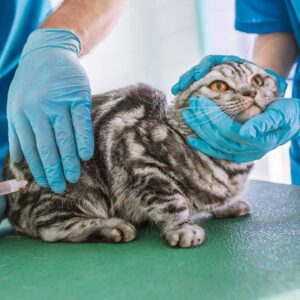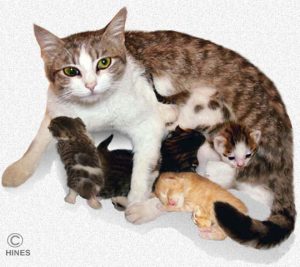Ron Hines DVM PhD
Ordinary, lovable, non-pedigree domestic short-hair cats are very fertile. When healthy, they are unlikely to run into problems giving birth. Cats in which humans have tinkered with cat genetics tend to be more problematic mothers. Ordinary cat litter size averages four or five kittens. For some reason, Siamese cats and crosses also have larger litters. Persians and other fancy breeds tend to be less fertile and give birth to smaller liters, as do all cats on their first liter. When the liter size exceeds 7 or 8, you might have to pitch in with supplemental feeding. Read about that here. Large litters tend to have one or two weaker littermates. A kitten’s placement in its Mom’s uterus has an influence on birth weight and later nursing success.
Is My Cat Likely To Run Into Problems During Her Pregnancy?
Over 99% of all cats are thought to deliver their kitten without assistance or complications. But when it’s your cat, it is comforting to know that things are proceeding without hitches and on schedule. Here are some of the things that should happen as your cat goes through a successful pregnancy:

If My Cat Is Pregnant, What Signs Might I See?
I mentioned that cats are very fertile. They are traditionally said to be capable of becoming pregnant as early as 8–10 months. But I have seen pregnant cats that I suspect were considerably younger (late in their fourth month). That is why I suggest that female cats be spayed when they reach 5 pounds/2.3 kg body weight regardless of their supposed age. Some don’t become fertile until they reach 7 pounds/3.2 kg. But that is impossible to predict. Once a cat has reached puberty, it should experience a fertile heat period and successful pregnancy about every 8–9 months when intact males are present. Some indoor cats, prevented from breeding, will come back into heat as frequently as every 2–3 weeks. Mature female cats tend to come into heat more frequently during long summer days than they do during the colder months when days are shorter. In the USA, March through September are the most frequent months for cats to come into heat, although exposure to 14 hours of artificial home light in the winter makes winter pregnancies more likely. Your cat’s heat periods are controlled by a hormone, LH, produced in it pituitary gland at the base of her brain. Sunlight (or any full spectrum indoor lighting) stimulates LH production. That in turn causes her ovaries to become active.

You might have noticed a few weeks ago that your cat was more vocal and loving. She might purr more. It may have begun rubbing back and forth on your leg or furniture. It might elevate its rump when you petted it. Those are all typical signs of heat. Perhaps, during one of those periods, it darted out your door. Perhaps your child left the door open. Perhaps it just your style to open the door to avoid litter box chores and odors. Whatever the reason, it makes an unintended pregnancy quite likely. A cat’s pregnancy averages about 64 days. It is generally between 63 and 67 (average 66 days) days – about 9–10 weeks.
Beginning after the first 3 weeks of pregnancy, your cat’s nipples will begin to swell. The nipple color will slowly change from white to a rosy pink. her nipples also grow in size and become firmer. It occurs gradually so, at first, all that can remain unnoticed. Buy major changes are already occurring in your cat’s body. Each egg it ovulated becomes the site of a corpus luteum. A powerful, hormone secreting nodule that takes control of pregnancy, should it occur. On very rare occasions, the corpus luteum will persist even though no mating occurred. That is called a pseudopregnancy. Pseudopregnant cats act just like pregnant cats. But they remain that way for 40–45 days, whereas a true pregnancy averages 66 days. Whichever the case, corpus lutea begin producing progesterone 1–2 days after ovulation and steadily increases for the next 10–15 days. The extra progesterone causes your cat’s breasts to swell. It causes its uterus and uterine horns (oviducts aka tubes) to swell. Cats and dogs don’t have uterine pregnancies. They have tubal pregnancies. The corpus luteum begin producing another hormone, relaxin, about 20 days into her pregnancy to encourage its pelvic canal to widen for the passage of kittens. From about day 35, prolactin production increases to aid in increased breast development.
By her 4th to 5th week, your cat’s belly will begin to swell, and it is obvious that she has put on weight. During this early time, your pet only needs a low-stress environment and a high-quality cat diet. Cheap cat foods can be low in taurine. A taurine deficiency has been associated with feline miscarriages and stillborn kittens. (read here) Keep her food available for her all day long and let her eat as much as she wants. To learn more about how to care for expectant mothers and their kittens, you can read my articles on orphan kittens and pregnant cat care. By the 5th or 6th week, you might be able to express thin milky fluid from her breasts.

Expect your cat to gain 2 – 4 pounds, or about 20- 25% of her normal weight during pregnancy. Pregnant cats rarely eat more than they need to. But do not let her get so fat that labor might become difficult.
During the final week or so of pregnancy, your cat might begin searching for a suitable kitten nest. Be sure your pregnant cat is confined indoors at this time. She might also become less tolerant of other pets in your household. Those large kittens are now putting pressure on her bladder. So she might experience litter box accidents. That increased abdominal pressure can also produce various signs of indigestion. As labor approaches, mother cats also tend to become restless. Some meow, some cry. This is the time you need to lead her to the spot you hope she will choose to deliver. I believe that you should begin introducing her to that secluded spot beginning some weeks earlier. At this point, she is unlikely to want to eat. When delivery is imminent, most cats’ body temperature will drop to 100F/37.8. Her normal body temperature was 101.0-102.5°F/38.3-39.2°C. If you intend to be present when your mother delivers, begin to take your cat’s temperature two weeks before its due date. Always take her temperature at the same time of day. You can lubricate a digital thermometer with margarine or KY jelly and insert it about a half inch up its rectum if she will tolerate that. Leave it in place for three minutes if possible. Ear thermometers are not as accurate. (read here) When the pet’s temperature drops below 100 F (37.8 C) she should deliver her kittens in less than twenty-four hours. You never want to see your cat’s temperature go above 102.5 during, or prior to delivery. That is often a sign of a serious birthing problem. Abdominal contractions and clear vaginal discharges during birthing are normal. However, odorous discharges and pussy or blood discharges are reasons to contact your veterinarian.

Things To Keep On Hand When Your Cat Is Expecting:
Keep plenty of clean towels on hand when your cat is expecting. Go to Walmart and purchase a bottle of tame iodine solution (Betadine™) antiseptic, some Q-tips and a pair of blunt scissors. Buy a package of dental floss in case you need to tie off the kitten’s umbilical cords. A baby nose suction bulb works well to clean mucus from the mouth and nose of infant kittens. Mother cats generally do an excellent job of keeping their kittens warm. If it is very cold, you can buy a heavy duty-heating pad. One must be very careful using standard human heating pads with small animals. A safer option is a hot water bottle that you refill with bath-temperature water now and then. It is generally only a rejected or orphan kitten that requires artificial warmth. Read about raising them here.

What Should I Expect During Delivery?
Twenty-four to forty-eight hours before labor begins, your cat will seem more anxious and restless. She will often poke her head about looking for a place to nest and have the litter. But this behavior sometimes occurs early as three days before the actual delivery. At this point, confine her to the room you want her to give birth in. It should be a darkened room with an impervious floor in a quiet area of the house that is not too cold or too hot. Place food and water in the room and let her get used to it. The most common place for a cat to choose to deliver is in the laundry room – often in the soiled cloth basket itself. If that is not an acceptable place to you, make it physically off limits or plan to use the laundromat for a while.
Cats that are about to go into labor will usually lick their abdomen and vagina persistently. There is often a discharge that precedes birthing, but the mother will lick it away as rapidly as it appears. Her cervix will be dilating, but no outward signs accompany this. Do not attempt to poke your finger in her.
She will lose all interest in food and become serious and attentive to only her licking. If you are perceptive, you may notice an increase in her breathing rate. It is quite common for the mother to sit with her mouth open and yowl loudly or pace the room. As her labor progresses and uterine contractions begin, pregnant cats will lay on their sides and intermittently squat and press downward to expel the kittens. Do not interrupt or disturb the mother during these periods – just watch from a door left ajar. Many of my clients want their young children to observe the “miracle of birth”. Your cat will not appreciate excited, noisy children.
What Will I See Then?
She should spend about 70% of her time nursing the kittens. Remember to keep a comfortable temperature in the room – kittens cannot regulate their body temperatures sufficiently during their first six days.
In a normal delivery, strong uterine contractions are accompanied by abdominal contractions and expulsion of the kittens. The first thing you will see is a small, greenish sac visible in the vagina, which will be followed by the kitten. The placenta is still attached to the kitten at this time. It will slowly drag out following each birth.
Although delivery of each kitten can take up to two hours, the average time is thirty to sixty minutes. A kitten should not spend more than fifteen minutes in the birth canal. While in the birth canal, pressure on the umbilical cord from the mother’s pelvic structures deprives the kitten of oxygen. If you should see a kitten in this predicament, grasp it gently through a soft clothe and pull it with a motion that is backwards and downwards. Grasp the kitten by its hips or shoulders and not by its legs or head. It is normal for kittens to arrive either head first or tail first.
After birth, the mother may discharge a bloody fluid for up to 10 days. Cats usually lick the discharge up as fast as it is produced. Only become concerned if the discharge becomes pus-like or has a strong odor.

Should My Pregnant Cat Be Examined By A Veterinarian?
I venture that 99% of kittens arrive in this world without their mothers having had a peripartum veterinary exam. That said, a veterinary exam early in pregnancy is a good idea to check on your cat’s general health or the likelihood that a troubled delivery might occur. That is particularly true when your pregnant cat is a pedigreed cat, intentionally, or unintentionally pregnant. By the 26th day of pregnancy, your veterinarian can usually feel the spherical lumps in your cat’s oviducts that are the developing fetuses. Sometimes they can be felt as early as day 20. Tense cats, and obstreperous cats might have to wait till day 30 – or never. You don’t want to forcefully restrain or drug a potentially pregnant cat. Kitten heartbeats can often be detected around day 26 – if your cat is not purring. From about day 18, veterinarians using ultrasound can detect the developing kittens and determine their number more accurately than by simply palpating your cat’s tummy.
By day 40-45, the kitten’s skeletons will have calcified enough to be seen on x-rays. But I do not suggest that cats be x-rayed to determine the size of the litter. The risks of radiation to staff and cat and the stress involved in the procedure are undesirable unless there is some clear indication that the pregnancy has gone wrong or that the cat has other health issues.
Another positive reason for bringing your cat in is to have it examined for fleas, ticks, ear mites and internal parasites (stool sample). Some medications are safe to give to pregnant cats and some are not. Let your veterinarian decide that. I would never give a potentially pregnant cat vaccines, and they don’t need the specialty diets, tonics, and vitamins that the staff might attempt to sell you. I would also never “drop off” a cat to be examined later. You need to be present when it is examined. I would also never board a pregnant cat.

How Long Should I Wait Before Consulting A Veterinarian When I Am Worried?
 I suggest that you contact your veterinarian if your pregnant cat shows any signs of illness or lack of appetite.
I suggest that you contact your veterinarian if your pregnant cat shows any signs of illness or lack of appetite.
 I suggest that you contact your veterinarian if you know when your cat became pregnant and more than 67 days have passed with no kittens, or abnormally few kittens.
I suggest that you contact your veterinarian if you know when your cat became pregnant and more than 67 days have passed with no kittens, or abnormally few kittens.
 I suggest that you contact your veterinarian if your cat’s rectal temperature has been 100F/37.8C. or less for more than one day. Or above 102F/38.9C at any point in her pregnancy.
I suggest that you contact your veterinarian if your cat’s rectal temperature has been 100F/37.8C. or less for more than one day. Or above 102F/38.9C at any point in her pregnancy.
 I suggest that you contact your veterinarian if a kitten becomes stuck in your cat’s birth canal for more than ten minutes.
I suggest that you contact your veterinarian if a kitten becomes stuck in your cat’s birth canal for more than ten minutes.
 I suggest that you contact your veterinarian if your cat has contractions that last for more than four hours but produces no kittens.
I suggest that you contact your veterinarian if your cat has contractions that last for more than four hours but produces no kittens.
 I suggest that you contact your veterinarian if five hours have passed since contractions began or the last kitten arrived, and you can still feel kittens in her tummy.
I suggest that you contact your veterinarian if five hours have passed since contractions began or the last kitten arrived, and you can still feel kittens in her tummy.
 I suggest that you contact your veterinarian if thick puss like material seeps from her vagina or if the discharge has a strong odor.
I suggest that you contact your veterinarian if thick puss like material seeps from her vagina or if the discharge has a strong odor.
 I suggest that you contact your veterinarian if fewer placentas were expelled than the number of kittens that arrived, and you are sure she did not eat any of them.
I suggest that you contact your veterinarian if fewer placentas were expelled than the number of kittens that arrived, and you are sure she did not eat any of them.
 I suggest that you contact your veterinarian if the kittens will nurse of if the mother refuses to nurse or attend to them.
I suggest that you contact your veterinarian if the kittens will nurse of if the mother refuses to nurse or attend to them.
 I suggest that you contact your veterinarian if any of her breasts are hot, painful, hard or discolored.
I suggest that you contact your veterinarian if any of her breasts are hot, painful, hard or discolored.
 I suggest that you contact your veterinarian if the kittens continuously cry and move about instead of nursing and sleeping peacefully.
I suggest that you contact your veterinarian if the kittens continuously cry and move about instead of nursing and sleeping peacefully.
Your first kitten should arrive within about an hour after the first onset of labor. Sometimes labor lasts only a few minutes before the first kitten arrives, sometimes it takes longer. The rest of the kittens usually arrive with an interval of about ten minutes to an hour between them. Each kitten arrives wrapped in a jelly-like membrane filled with clear fluid – its amniotic sac. Good mothers immediately begin licking their kittens forcefully, which shreds this sac, allowing the kitten to breathe. This licking also stimulates the kitten’s circulation and respiration and increases uterine contractions.
In the exceptionally rare case where the mother does not free the kitten’s mouth from the obstructing membrane, you should do it for her and follow that with a vigorous rubbing of the kitten in a soft towel to dry it and stimulate it to breathe. Kittens are delicate – so don’t over-do the rubbing. The mother will also chew off the umbilical cord at this time. If she forgets to do that for one or more of the kittens, you can tie off the cord with a length of dental floss or string and snip the cord about an inch above that. It is important to let the mother do these things herself if she is willing to, because through licking and mothering the kitten she bonds with the kitten and recognizes it as her own infant. It also helps her to “let down” her milk.
Your mother cat will probably begin nursing kittens before all of the littermate arrive. If she doesn’t, place the kitten(s) on one of her nipples. The nursing should, as I mentioned, stimulate her uterus to contract further, so you may see a bloody or greenish discharge from her vagina. That is normal. She may eat a few of the afterbirths. There is no problem in that. It often takes two to six hours for the entire litter to be delivered. While she is delivering keep her area quiet, calm and dimly lit. Observe from a distance and don’t become involved in the birthing unless you are certain that you are needed. Once the last kitten has been delivered, you can quietly clean up the mess she has left behind. Place a fresh bowel of water and some cat food beside her because mother cats are hesitant to leave their kittens for the first day or two.
You are on the Vetspace animal health website
Visiting the products that you see displayed on this website help pay the cost of keeping these articles on the Internet






